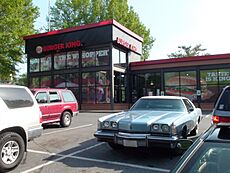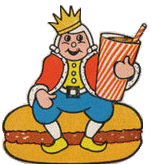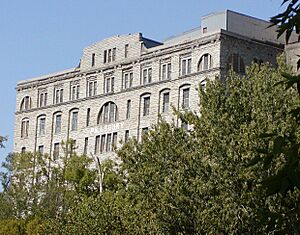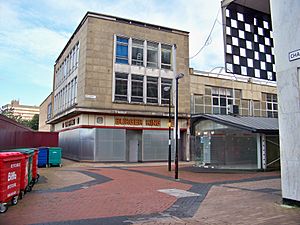History of Burger King facts for kids
The story of the international fast food chain Burger King began on July 23, 1954. It started in Jacksonville, Florida, and was first called Insta-Burger King. The founders, Keith J. Cramer and his stepfather Matthew Burns, were inspired by the first McDonald's restaurant. They bought special cooking machines called "Insta" machines. Their first restaurants used a cooking device called the Insta-Broiler, which was great at cooking burgers. They even made sure all their new restaurants (franchises) used this machine.
In 1959, the original company faced problems. Two franchisees from Miami, Florida, James McLamore and David R. Edgerton, bought the company. They changed its name to Burger King. McLamore and Edgerton ran the company on their own for eight years, growing it to over 250 locations in the United States. In 1967, they sold Burger King to the Pillsbury Company.
Pillsbury tried to improve Burger King in the late 1970s and early 1980s. A big change happened in 1978 when Burger King hired Donald N. Smith, an executive from McDonald's. He started a plan called Operation Phoenix to change how the company worked. This included new rules for franchises, more items on the menu, and new restaurant designs to make all Burger King locations look similar. These changes helped at first, but many were later stopped. This caused Burger King to struggle financially, which also hurt Pillsbury.
Poor management continued to affect the company for many years. Even after it was bought by the British company Grand Metropolitan in 1989, and then by Diageo, the brand was neglected. This neglect caused many Burger King restaurants to close and the company's value to drop a lot. Diageo decided to sell the struggling chain in 2000.
In the 21st century, Burger King became independent again. A group of investment companies, led by TPG Capital, bought it from Diageo for about $1.5 billion in 2002. The new owners quickly worked to make the company better. In 2006, Burger King became a public company again, meaning its shares could be bought and sold on the stock market. Their plan included new ads, a new menu, programs to update restaurants, and a new restaurant idea called the BK Whopper Bar. These changes helped the company grow.
However, the financial crisis of 2007-2010 made things difficult for Burger King, while McDonald's continued to do well. Burger King's value dropped, and TPG and its partners sold their share to 3G Capital of Brazil for $3.26 billion. Experts believed 3G would need to invest a lot to help Burger King recover. After the sale, Burger King's stock was removed from the New York Stock Exchange. This was done so the company could focus on fixing its business without worrying about pleasing shareholders. Later, 3G made Burger King public again. Eventually, Burger King joined with the Canadian donut and coffee chain Tim Hortons.
Contents
History of Burger King
Early Days: Insta-Burger King
Burger King started in 1953 in Jacksonville, Florida. It was first called Insta-Burger King. Keith J. Kramer and his wife's uncle, Matthew Burns, founded it. Their first restaurants used a special cooking machine called the Insta-Broiler. This machine was very good at cooking burgers. It was so successful that as they opened more restaurants (franchises), they made sure all of them had this machine.
Meanwhile, two friends, James McLamore and David R. Edgerton, wanted to start their own business. McLamore had visited the first McDonald's hamburger stand in San Bernardino, California. He saw how successful their fast way of making food was. So, he decided to open a similar business.
McLamore and Edgerton got a license to open an Insta-Burger King. Their first location opened on December 4, 1954, in Miami. By 1959, they had several restaurants in the Miami area, and their business was growing fast. However, they found that the Insta-Broiler machines had a problem: the heating parts wore out from the burger drippings. The two friends then created a new cooking machine. It was a gas grill that cooked meat patties in a different way. They called it the flame broiler. This new machine cooked patties vertically on a chain, giving them grill marks like a charcoal grill. It worked so well that they replaced all their old Insta-Broilers with the new flame broiler.
Even though the original Insta-Burger King had grown quickly, it faced financial problems by 1959. McLamore and Edgerton bought the rights to the entire chain in 1959. They renamed their company Burger King of Miami. This company later became Burger King Corporation. It began selling licenses to open Burger King restaurants across the United States.
During this time, Burger King also created two things that are still famous today. The first was its mascot, the Burger King, in 1955. This character has been in their ads for over 60 years. The second was the company's most famous sandwich, the Whopper. James McLamore created the Whopper in 1957, and it first sold for 37 cents. McLamore made it after seeing another restaurant selling a bigger burger successfully. He thought the size was key, so he made the Whopper. He chose the name because he felt it sounded "big." Also, in 1958, Burger King started advertising on television for the first time.
Pillsbury Company Takes Over
In 1967, the Pillsbury Company bought Burger King from McLamore and Edgerton. At that time, Burger King had 274 restaurants in the United States and was worth about $18 million. After buying Burger King, Pillsbury found that the restaurants were not all the same. McLamore and Edgerton's system allowed Burger King to grow fast, but it didn't have strict rules for how franchisees (people who owned individual restaurants) ran their businesses. This led to differences in food quality and service, which hurt Burger King's reputation. Also, the agreements didn't give Pillsbury enough power to control what the franchisees did.
One example of these problems was with a large franchisee called Chart House. This company owned many Burger King restaurants. By 1970, Chart House had over 350 Burger King stores across the country. They even had their own buying system and training programs. In 1973, Chart House tried to buy Burger King from Pillsbury, but Pillsbury said no. The relationship between Pillsbury and Chart House became difficult. Eventually, Pillsbury bought Chart House's Burger King restaurants in 1984.
In 1978, Burger King hired Donald N. Smith, an executive from McDonald's, to help fix the company. Smith changed the rules for new franchise agreements. New owners had to live close to their restaurants. Companies were not allowed to own franchises, and franchisees couldn't own other restaurant chains. These new rules limited how big a franchisee could become. It also became a rule that Burger King Corporation would own the land for new stores and lease it to franchisees. This allowed the company to take over struggling restaurants or remove owners who didn't follow the rules.
Besides changing the franchise system, Smith also updated Burger King's operations to better compete with McDonald's and the growing chain Wendy's. He added more items to the menu, like the Burger King specialty sandwich line in 1979. He also added chicken and fish sandwiches. These new items were successful, and the company's sales went up by 15%.
After Smith left Burger King in 1980, sales started to drop. Pillsbury asked Norman E. Brinker to turn the brand around. One of his first actions was to start an advertising campaign. These ads claimed that Burger King's flame-broiled burgers were better and bigger than McDonald's. These ads were very controversial because fast food companies usually didn't mention competitors by name. McDonald's sued Burger King and their ad agency. Even child actress Sarah Michelle Gellar was involved in the lawsuit because she appeared in these TV ads. The lawsuit was settled later. Despite the controversy, these "Burger Wars" ads increased sales in existing stores. Brinker continued to work for the company until 1984 when he left to lead the restaurant chain Chili's.
After Smith and Brinker left, Pillsbury relaxed many of their changes. They also built fewer new restaurants, which stopped the company's growth. By not continuing the changes these two men made, Pillsbury hurt its own value. Burger King made up more than a third of Pillsbury's sales and two-thirds of its profits. When the British alcohol company Grand Metropolitan PLC tried to buy Pillsbury, Pillsbury tried to sell off Burger King to raise money and stop the takeover. This plan would have made Burger King a separate company again.
However, Burger King's franchisees rejected the plan. They worried that it would stop Burger King from growing and hurt their businesses. Pillsbury also faced lawsuits from investors. These problems eventually forced Pillsbury to give up, and Grand Metropolitan bought Pillsbury in November 1988 for $5.7 billion.
Grand Metropolitan Takes Charge
After buying Pillsbury in January 1989, Grand Metropolitan immediately started making changes at Burger King. Grand Met's CEO, Allen Sheppard, wanted to improve Burger King's performance and make it the second-largest fast-food burger chain in the world. To do this, he planned to review operations, change staff, and make structural improvements.
The company believed it needed a consistent marketing plan and management team. So, they replaced Burger King's chairman and CEO with their own executives. Grand Met's first big change was to break up Burger King's old purchasing and distribution group, Distron. They reorganized it into two separate groups: one for buying supplies and one for distribution. This change led to many job cuts.
In the five years before Grand Met bought Burger King, the restaurant chain had many different ad campaigns and marketing directors. This led to "sloppy strategic planning." To fix this, Grand Met reviewed all advertising. They changed advertising agencies, hoping to create a clear brand identity for Burger King.
Grand Met also tried to grow Burger King's business and expand it globally. They created the BK Expressway concept, which were smaller restaurants for places like sports stadiums and airports. These smaller stores had a simpler menu and were cheaper to open for franchisees. In the same year, Grand Met expanded Burger King in Europe by buying United Biscuits' restaurants, including the nearly 400-location burger chain Wimpy in the UK. Grand Met converted some Wimpy locations into Burger King restaurants. This helped Burger King grow from about 30 restaurants in the UK to over 60 within a year.
In the 1990s, Grand Met changed Burger King's soft drink supplier from Pepsi to Coca-Cola. Pepsi had been the supplier since 1983 and had many promotions with Burger King. However, because PepsiCo also owned its own fast food restaurants, Burger King moved its drink contract back to Coca-Cola. With Coca-Cola's return, Burger King also introduced its first major new chicken sandwich since 1977, the BK Broiler. This broiled sandwich was aimed at customers who wanted healthier options. The BK Broiler was very popular, selling over a million sandwiches daily within six months.
Burger King also made a big advertising deal that year. They signed a contract with the Walt Disney Company for 10 movies, including The Lion King, Aladdin, and Toy Story. This deal came when Disney movies were very popular. Along with a new BK Kid's Club program, Burger King saw a huge increase in sales to children. Over a million children joined the Kid's Club within two months.
While many of Grand Met's changes helped sales and growth, Burger King still had problems. In 1992, Hurricane Andrew destroyed Burger King's headquarters in Miami. The building was in the direct path of the hurricane and suffered over $24 million in damage. Many of the 700 staff members were left homeless. The CEO, Barry Gibbons, immediately started a plan to help the company recover. They moved important computer data to Seattle, Washington, before the storm. They also set up a temporary office and shifted some work to regional offices. The headquarters took over a year to rebuild.
Gibbons also focused on helping his staff. He made job roles more flexible and encouraged staff to take initiative. A company daycare was set up, and dress codes were relaxed. The company brought in counselors, insurance experts, and other professionals to help staff with their personal situations. They even arranged emergency loans for employees.
By 1993, Gibbons left his CEO role and was replaced by James B. Adamson. Adamson continued plans to expand Burger King into new places like universities, gas stations, airports, and sports arenas. He also worked to simplify Burger King's menu and improve relationships with franchisees. His changes led to a 28 percent increase in sales in 1995. He left in early 1995 and was temporarily replaced by David Nash, then Robert Lowes.
Diageo's Ownership
In 1997, Grand Metropolitan merged with Guinness to form a new company called Diageo. This deal was worth $22 billion. Franchisees complained that Diageo ignored Burger King and focused more on its alcohol business. There were two more CEOs during the time Diageo owned the company.
This neglect hurt Burger King even more. Its sales and market share dropped a lot. Burger King nearly tied with Wendy's for second place in the US burger market. For many years, Burger King and its owners, along with many large franchisees, closed many restaurants that were not doing well. Several of its biggest franchisees even went bankrupt because of the problems with the brand.
Diageo owned Burger King until 2000. Then, Diageo decided to focus only on its drink products and sell the restaurant chain. In 2001, they planned to sell about 20 percent of Burger King's shares on the stock market. However, Burger King's franchise group, the National Franchise Association (NFA), tried to stop this. They believed that any money raised would not be used to help Burger King, but instead would go to Diageo's liquor brands.
Instead, the NFA tried to buy Burger King from Diageo, but they couldn't get enough money together.
TPG Capital Takes Over
In 2002, three investment companies led by TPG Capital, along with Bain Capital and Goldman Sachs Capital Partners, agreed to buy Burger King from Diageo for $1.5 billion. The sale was completed in December 2002. The new owners, through several new CEOs, worked to make the company better. Their first big move was to rename the parent company Burger King Brands. The investment group initially planned to make Burger King a public company within two years, but this was delayed until 2006. On February 1, 2006, CEO Greg Brenneman announced plans to make Burger King a publicly traded company by selling shares to the public.
On May 18, 2006, Burger King started trading on the New York Stock Exchange under the symbol BKC. The sale of stock brought in $425 million, which was the largest stock sale for a US-based restaurant chain at that time. The money was used to pay back a loan the company had taken out.
By mid-2008, Burger King had grown significantly in the US for the first time in years. For more than a dozen financial periods, the company showed increased sales and expansion. In the first half of 2008, the company started a plan to update or remodel almost all of its North American restaurants. These renovations helped increase sales in existing stores by 5.4 percent.
More modernization plans came in 2009 with the company's "20/20" store designs and its "BK Whopper Bar" concept. The 20/20 design featured bright colors and modern materials. It also included new digital menu boards. All new Burger King locations and future renovations would use this design. The main challenge was the cost for individual restaurant owners, who had to pay between $300,000 and $600,000 for renovations.
The Whopper Bar was a new idea that changed Burger King's traditional fast food style. These locations had an open kitchen where customers could watch their "Whopperistas" make their orders. The design was more "playful" and aimed to compete with fancier casual restaurants. These Whopper Bars were designed for places like malls, airports, and casinos.
In 2010, Burger King announced that its Whopper Bar locations in the United States would sell beer. While beer was already available at Burger King restaurants in Europe, this was the first time a major fast food chain tried to sell beer in the US. The company sold popular beers in aluminum bottles. This move was aimed at customers aged 30 and under. Some experts thought it was risky, but others believed it was a smart move as the company's customer base was getting older.
3G Capital Takes Over

The most recent chapter in Burger King's ownership began in September 2010. TPG and its partners announced they would sell their share in Burger King to another investment company, 3G Capital, for $3.26 billion. Between 2004 and 2009, Burger King had many profitable periods, which helped re-energize the company. However, during the financial crisis of 2007-2010, Burger King's business declined, while McDonald's continued to grow. Experts said that Burger King's struggles were partly because it relied too much on its most frequent customers, who visited less during the recession.
The offer from 3G Capital was a surprise to Burger King's CEO, John Chidsey. The sale was expected to help the company fix its basic business problems and catch up to McDonald's. Analysts believed 3G would need to invest a lot of money to turn things around. They said it would take several years to brighten up locations and stabilize sales.
After the purchase was completed in October 2010, 3G immediately started changing the company. Seven top executives were let go, and 261 employees were laid off from the company's headquarters. Chidsey resigned in April 2011 and was replaced by Alex Behring, one of 3G's partners. Bernardo Hees became the new CEO.
As part of the changes, 3G also updated many parts of Burger King's operations in 2011–2012. One of the first moves was to end Burger King's relationship with its advertising agency and hire a new one. 3G also started changing the menu, beginning with an improved version of Burger King's Chicken Tenders. Other new or updated products followed. 3G also decided to sell most of the company-owned restaurants to franchisees. This made Burger King more like competitors such as Subway and KFC, which are mostly run by franchisees. 3G also worked to improve relationships with its American franchisees, which had been difficult under the previous owners. Several lawsuits were settled, and company rules that caused disputes were changed.
In 2011, 3G partnered with a British company to make Burger King public again. They also planned a huge expansion of restaurants through franchising in countries like Brazil, Russia, India, China (BRIC nations), and Africa, with over 2,500 new locations planned.
In August 2014, Burger King announced it wanted to buy the Canadian restaurant and coffee shop chain Tim Hortons. 3G Capital bought Tim Hortons, and a new holding company was formed in Oakville, Ontario, Canada. 3G owns most of this new company. Berkshire Hathaway helped fund the purchase by buying $3 billion worth of special shares. Burger King CEO Daniel Schwartz became the CEO of the new company. The two chains kept their separate operations, with Burger King staying in its Miami headquarters. The merger was approved by Tim Hortons shareholders and Canadian authorities. A Tim Hortons representative said the merger would help Tim Hortons grow internationally by using Burger King's resources. The combined company became the third-largest international fast food chain.
The merger also involved a "tax inversion," where a company moves its headquarters to a country with lower taxes. While this can reduce taxes, Burger King had already used ways to lower its tax rate. US politicians criticized this move, worrying about losing tax revenue.
In 2018, Burger King moved into a new headquarters building.
Important Dates
Here are some key moments in Burger King's history:
- 1953: Insta-Burger King is started in Jacksonville, FL.
- 1954: James McLamore and David Edgerton buy Insta-Burger King and rename it Burger King.
- 1955: The Burger King character is created.
- 1957: The Whopper sandwich is launched.
- 1958: Burger King releases its first TV advertisement.
- 1959: Burger King creates its system for selling franchises.
- 1967: The Pillsbury Company buys Burger King for $18 million.
- 1977: Donald N. Smith from McDonald's is hired to help improve the company.
- 1980: Smith leaves Burger King.
- 1981: Norman E. Brinker becomes head of Pillsbury's restaurant division, including Burger King.
- 1982: Burger King airs controversial ads that criticize its competitor's fried burgers.
- 1984: Brinker leaves the company.
- 1989: British company Grand Metropolitan buys Pillsbury for $5.7 billion.
- 1996: Burger King co-founder James McLamore passes away.
- 1997: Grand Metropolitan and Guinness merge to form Diageo.
- 2000: Diageo considers selling Burger King.
- 2001: A group of North American franchisees tries to buy the company.
- 2002: Investment firm Texas Pacific Group buys Burger King from Diageo for $1.5 billion.
- 2006: Burger King becomes a public company and is listed on the NYSE.
- 2009: The company opens its 12,000th store in Beijing, China.
- 2010: Brazil-based 3G Capital buys Burger King for $3.26 billion.
- 2011: Burger King begins a year-long effort to update its menu and advertising.
- 2012: Burger King is taken public again on the NYSE.
- 2014: Burger King merges with Canadian donut and coffee chain Tim Hortons in a deal worth $18 billion.
- 2019: Burger King plans to close up to 250 less busy locations each year, starting in 2020.
Ownership History
Since it was founded in 1954, Burger King has changed owners five times. Also, during Grand Metropolitan's ownership, it merged with Guinness to form Diageo. TPG Capital shared ownership with Bain Capital and Goldman Sachs Capital Partners. When 3G Capital owned Burger King, they sold a part of the chain to Justice Holdings when it became public again in 2012. When Burger King merged with Tim Hortons in 2014, Berkshire Hathaway invested in the new combined company.
| Owner | From | To | Key People | Notes |
|---|---|---|---|---|
| Insta-Burger King | 1953 | 1959 | Kieth Kramer, Matthew Burns | |
| Burger King | 1959 | 1967 | James McLamore, David R. Edgerton | |
| Pillsbury | 1967 | 1988 | Donald N. Smith, Norman E. Brinker | |
| Grand Met/Diageo | 1988 | 2002 | ||
| TPG Capital | 2002 | 2010 | ||
| 3G Capital | 2010 | present |
See also
- History of KFC
- History of McDonald's






